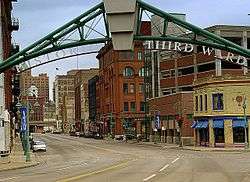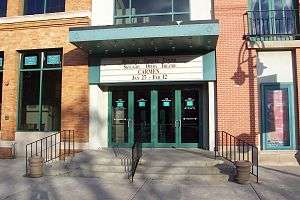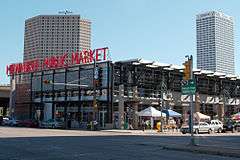Historic Third Ward, Milwaukee
|
Historic Third Ward District | |
 Third Ward Neighborhood | |
  | |
| Location | Milwaukee, Wisconsin |
|---|---|
| Coordinates | 43°01′58″N 87°54′21″W / 43.0328°N 87.9057°WCoordinates: 43°01′58″N 87°54′21″W / 43.0328°N 87.9057°W |
| Built | 1875 |
| Architect | Multiple |
| Architectural style | Late Victorian |
| NRHP Reference # | 84003724 [1] |
| Added to NRHP | March 8, 1984 |
The Historic Third Ward is a historic warehouse district located in downtown Milwaukee, Wisconsin. This Milwaukee neighborhood is listed on the National Register of Historic Places. Today, the Third Ward is home to over 450 businesses and maintains a strong position within the retail and professional service community in Milwaukee as a showcase of a mixed-use district. The neighborhood's renaissance is anchored by many specialty shops, restaurants, art galleries and theatre groups, creative businesses and condos. It is home to the Milwaukee Institute of Art and Design (MIAD), and the Broadway Theatre Center. The Ward is adjacent to the Summerfest grounds. The district is bounded by the Milwaukee River to the west and south, E. St. Paul Ave to the north, and N. Jackson St. to the east.[2]
History
During the early years of Milwaukee, the Third Ward was a relatively flat, swampy area. The land was drained, and soon houses populated the west side of the Ward, while along the east side of the Milwaukee River, factories and warehouses were built. Irish immigrants were the early settlers of the area. The Ward became known as the "Bloody Third," a reputation the area earned for its frequent fistfights.
The first railroad linked Milwaukee to the Mississippi River in 1856, letting the wholesalers supply needed goods to the population of settlers in the West. The Irish settlers in the Third ward went through two major tragedies. On September 7, 1860 the Lady Elgin steamship left Milwaukee carrying a large number of passengers from the Third Ward's Irish community. Over 400 people are believed to have died when the ship sank and is the second greatest loss of life seen on the Great Lakes. A Wisconsin Historical Marker in the Third Ward commemorates the tragedy while a monument dedicated at Calvary Cemetery serves as a cenotaph.
The second tragedy struck on October 28, 1892. A fire started in the Water Street Union Oil & Paint Co. Strong winds of up to 50 mph helped to spread the fire to the Ward's other buildings. In no time at all, the fire was out of control. Cities such as Chicago and Oshkosh helped Milwaukee's fire department fight the flames by sending horse-drawn units by rail. 440 buildings were destroyed and more than 1,900 people, mostly Irish families, were left without homes by the time the fire was finally under control at midnight.
Prominent local architects stepped in to design many of the commercial structures after the 1892 fire. Over the next 36 years construction continued, giving the buildings an interesting continuity that unifies the neighborhood because of this relatively short time of development.
Italian immigrants replaced the Irish, during this period of reconstruction, and the Irish had moved to different areas in the city. The Italians were very prolific in the warehouse businesses, establishing Commission Row, a grouping of grocery commission houses. By 1915, 29 Italian saloons, 45 Italian groceries, an Italian bank and two spaghetti factories populated the Ward. Grocery warehouses, liquor distributors dry goods businesses and manufacturers were the business that flourished during this time.
Highway construction displaced the close-knit Italian Third Ward community in the 1960s. The trucking industry and suburb growth led to the decline of warehouse operations and industry. Ironically, Milwaukee's first architectural landmark was named in 1967, the Blessed Virgin of Pompeii Catholic Church, the same year it was demolished for construction of the I-794 freeway.
In 2000, the Historic Third Ward Association began co-sponsoring Milwaukee's premier art event, Gallery Night and Day, a quarterly event which attracts thousands of visitors to the neighborhood. The Historic Third Ward recently experienced an influx of upscale women's boutiques, restaurants and high-end furnishings businesses. The Milwaukee Public Market also offers year-round indoor gourmet and specialty food shopping.
In 2010, Erie Street Plaza, a small park and public space built on a former parking lot, opened on the southern edge of the neighborhood, near the confluence of the Milwaukee River and Kinnickinnic River.[3]
- More recent events in history
- 1970s
- Business owners unite together to successfully combat a proposed "red light" district in the neighborhood
- 1980s
- "The Historic Third Ward District" is established by the National Register of Historic Places as it accepts 70 buildings spanning approximately 10 square blocks in the district.
- MIAD moves to current location
- Buffalo Street Bridge is removed, eliminating a valuable access point to the Ward. Further isolating the Third Ward but also helping to maintain its unique atmosphere.
- 1990s
- $3.4 million streetscapes project was completed as well as two parking structures, further the economic boom in the area.
- The area begins to see its first new construction. Projects going from renovation to new construction.
- The riverwalk is created and connects downtown and the Third Ward.
- Major streetscaping begins.
- 2000s
- Milwaukee Public Market opens
- Proposal for a new hotel signalling a change for the neighborhood and its use.
- Construction and renovation moves south of the river creating a new Fifth Ward neighborhood.
Education
The school district is Milwaukee Public Schools.[4]
Photos of the Third Ward
 Renovated warehouse
Renovated warehouse New lofts and shops
New lofts and shops New lofts
New lofts Buildings not renovated
Buildings not renovated The Broadway Theatre Center
The Broadway Theatre Center
See also
References
- ↑ National Park Service (2006-03-15). "National Register Information System". National Register of Historic Places. National Park Service.
- ↑ "Historic Third Ward District". National Register of Historic Places. National Park Service. March 8, 1984. Retrieved May 11, 2016.
- ↑ http://landscapeperformance.org/case-study-briefs/erie-street-plaza
- ↑ Konya, Rebecca R. (2010-07-04). "Third Ward". Milwaukee Journal-Sentinel. Archived from the original on 2010-07-04. Retrieved 2017-01-01.
External links
- Historic Third Ward Association
- Milwaukee Public Market
- Historic Third Ward in Milwaukee Neighborhoods Guide from UWM Library
